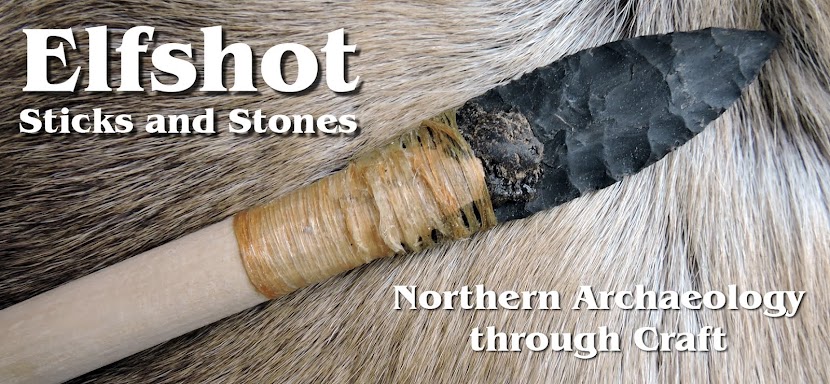 |
| Beothuk Arrow Reproductions |
Arrows played a significant role in the lives of the Beothuk. Beyond their function in hunting game for food, clothing, tools, and shelter the Beothuk believed that the first men and women were created from arrows stuck in the ground, and arrows were often included as grave goods in burials.
 |
| Recent Indian Points |
Over the years there have been
hundreds of stone arrowheads found at Recent Indian sites on the Island of Newfoundland, but we don't have much direct evidence of what Beothuk arrows looked like. There were a few fragments collected and photographed over 100 years ago, but as far as I can tell, these artifacts aren't in the Province anymore. They are not in the Archaeology Collection at The Rooms, which means that they might have found their way into a museum somewhere else in Canada or perhaps the UK.
 |
| #2s are arrows, #4s are kids arrows |
The Beothuk arrow reproductions that I make are based on the archaeologically recovered chert arrowheads, the photo of the arrow and bow parts in James P. Howley's 1915 book;
The Beothucks or Red Indians: The Aboriginal Inhabitants of Newfoundland
and the additional written descriptions collected in Howley's book. Although no complete arrows survive there are several first hand accounts made by Europeans who saw them.
 |
| Planing down the pine shaft |
They are described as being a yard long, or the distance from the center of the chest to the tip of an outstretched fingertips, which approximates the length of the draw on the bow. The shaft is pine and they were always fletched with two strips of goose feathers. I start with straight grained pine board and cut it or split it into square dowels about 3/4 of an inch wide that I then plane down using a small Stanley plane.
 |
| Big nocks for big string |
Based on the photos, the arrows taper towards the arrowhead and have a V-shaped or U-shaped nock cut into the opposite end. The arrow appears to widen into a slight flare around the nock, although it also looks like they are thinned flatly into a rectangular cross-section. This creates a wide strong nock and it also creates two convenient flat facets to tie the feathers to. The nock is larger than on modern arrows because the sinew bow strings available to the Beothuks would have been much thicker than today's commercially made bowstrings.
 |
| Feathers create drag and spin |
I use two Canada Goose feathers from the same wing so that when they are split and tied to the shaft they spiral in the same direction and help spin the arrow while in flight. A spinning projectile travels truer than one that flies flatly - its the same idea as putting rifling inside a gun barrel. The historic accounts all agree on the number of feathers (two) and the type (goose), but they don't offer a lot of detail on the specifics of how the feathers are cut or glued to the shaft.
 |
| Map detail of Beothuk bow and Arrows |
There is a small drawing of a Beothuk bow and arrows in the legend of a map of the Exploits River completed by John Cartwright in 1773 maps that I use as a reference for the feathers. The arrows depicted in the drawing are tipped with iron points and have relatively long strips of close cropped feathers. I doubt that the bows changed much with the introduction of iron to the Beothuk toolkit, but I often wonder how different the arrows tipped with iron heads would have been from the arrows tipped with stone.
 |
| Two long thin strips of goose feathers |
Sometimes I play around with different styles of feathers on the arrows, just to remind myself that the fletching that suits the larger iron arrowheads may not have been the best for lighter stone points that preceded them.
 |
| Tying on the feathers |
I use sinew and hide glue for the binding materials for both the arrowhead and the feathers. Pine pitch is an option and is quite common on Innu tools from Labrador. I'm sure that it was known to the Beothuks, but I'm not aware of any direct evidence of pitch glue on any of their artifacts and its not mentioned in the historic texts. Although under a coating of red ochre, the pitch wouldn't be very noticeable, which is how the Beothuk finished all of their posessions. I stain the arrows with a red ochre, linseed oil, egg and water mixture. I want to experiment in the future with substituting caribou grease and seal oil for the linseed oil.
 |
| Complete Beothuk arrow reproduction |
Photo Credits:
1,2 4-6, 7, 8:Tim Rast
3: Plate from
Howley 1915
from
NF Heritage Website
9: Eric Walsh


















































